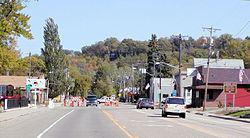Country United States County Dakota ZIP code 55150 Elevation 234 m Population 205 (2013) Added to NRHP 22 June 1970 | Time zone Central (CST) (UTC-6) Area code(s) 651 Area 20 ha Local time Saturday 7:02 PM | |
 | ||
Weather 5°C, Wind N at 6 km/h, 49% Humidity | ||
Mendota is a city in Dakota County, Minnesota, United States. The name is derived from the Dakota language, meaning "mouth or junction of one river with another. The population was 198 at the 2010 census.
Contents
Map of Mendota, MN, USA
History
The town was one of the first permanent settlements in the state of Minnesota, being founded around the same time as Fort Snelling. It also houses a small museum which used to be the Hypolite Du Puis house, the Henry Hastings Sibley house, the Faribault house, and buildings associated with the American Fur Company, all dating from the 1830s. The main route through the small city is State Highway 13, also known as Sibley Memorial Highway. Other roads in the city are mainly small unimproved roads.
Geography
According to the United States Census Bureau, the city has a total area of 0.30 square miles (0.78 km2), of which 0.27 square miles (0.70 km2) is land and 0.03 square miles (0.08 km2) is water.
The city of Mendota is located at the confluence of the Mississippi and Minnesota rivers. The city is surrounded on three sides by the city of Mendota Heights. Fort Snelling State Park is nearby.
2010 census
As of the census of 2010, there were 198 people, 78 households, and 52 families residing in the city. The population density was 733.3 inhabitants per square mile (283.1/km2). There were 82 housing units at an average density of 303.7 per square mile (117.3/km2). The racial makeup of the city was 91.4% White, 1.5% African American, 1.5% Native American, 2.0% Asian, 1.5% from other races, and 2.0% from two or more races. Hispanic or Latino of any race were 3.5% of the population.
There were 78 households of which 34.6% had children under the age of 18 living with them, 46.2% were married couples living together, 12.8% had a female householder with no husband present, 7.7% had a male householder with no wife present, and 33.3% were non-families. 26.9% of all households were made up of individuals and 2.6% had someone living alone who was 65 years of age or older. The average household size was 2.54 and the average family size was 3.06.
The median age in the city was 37.8 years. 26.8% of residents were under the age of 18; 5.5% were between the ages of 18 and 24; 27.4% were from 25 to 44; 30.4% were from 45 to 64; and 10.1% were 65 years of age or older. The gender makeup of the city was 47.5% male and 52.5% female.
2000 census
As of the census of 2000, there were 197 people, 80 households, and 48 families residing in the city. The population density was 1,045.8 people per square mile (400.3/km²). There were 80 housing units at an average density of 424.7 per square mile (162.6/km²). The racial makeup of the city was 92.39% White, 1.52% African American, 2.03% Native American, 0.51% Asian, 0.51% from other races, and 3.05% from two or more races.
There were 80 households out of which 33.8% had children under the age of 18 living with them, 35.0% were married couples living together, 16.3% had a female householder with no husband present, and 40.0% were non-families. 28.8% of all households were made up of individuals and 7.5% had someone living alone who was 65 years of age or older. The average household size was 2.46 and the average family size was 3.08.
In the city, the population was spread out with 25.9% under the age of 18, 7.1% from 18 to 24, 33.0% from 25 to 44, 23.9% from 45 to 64, and 10.2% who were 65 years of age or older. The median age was 36 years. For every 100 females there were 126.4 males. For every 100 females age 18 and over, there were 124.6 males.
The median income for a household in the city was $45,938, and the median income for a family was $51,250. Males had a median income of $40,750 versus $26,250 for females. The per capita income for the city was $26,745. None of the families and 1.3% of the population were living below the poverty line.
